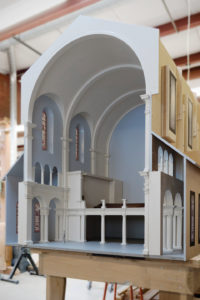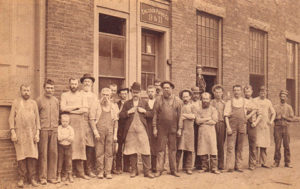St. John’s Episcopal Church
Lafayette, Indiana
Quimby Pipe Organs Inc.
Warrensburg, Missouri
View the Stop List
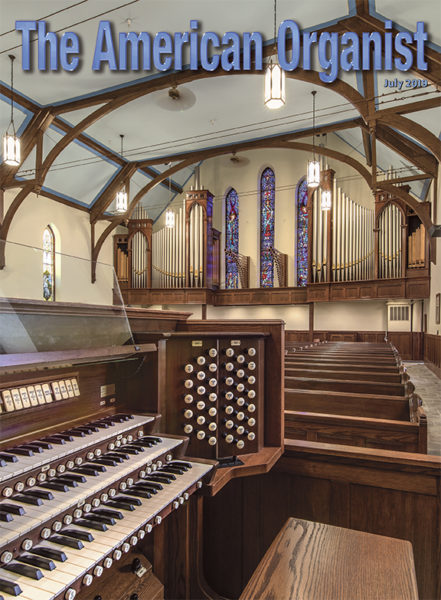
St. John’s Episcopal Church is a thriving parish located in downtown Lafayette, Indiana. Music has been an important focus of the parish since it was organized in 1836. Upon the completion of the present building in 1857, a secondhand 1853 Pilcher organ was first rented and later purchased. In 1889, the first paid choirmaster and choristers were engaged, and a men and boys’ choir “reorganized,” which continued until 1960. A new Pilcher was installed in 1890; this instrument was subsequently enlarged and electrified by Pilcher in the 1920s. In 1966, due to failing mechanisms and changing taste, a new two-manual, 29-rank Wicks replaced the rebuilt Pilcher. That organ was installed on a new, elevated platform at gallery level at the rear of the nave. While the organ was at the back of the nave, the choir sang from the front, where the console was also located.
In 2015, Michael Quimby and I were invited to assess this instrument, and to determine what, if anything, could be salvaged from it and reused in a major rebuild or new organ. We found an instrument that was dated tonally, but more importantly, wasn’t meeting the musical needs of the parish and choir.
What we discovered in terms of pipework was typical for its era: open-toe flues with little to no nicking, on light wind pressures, with voicing clearly inspired by the Organ Reform Movement. However, the hallmarks of typical Wicks factory work were also present—that is, solidly constructed pipes with heavier metal gauges than most mid-20th-century neo-Baroque organs: solid, heavy zinc basses, good spotted metal for principals, Hoyt metal for flutes, and beautifully constructed bourdons and gedeckts. These were all indicators that the majority of the existing flue pipework would respond very well to rescaling and revoicing.

The reeds were a different story. Michael Bennett, director of music, indicated a clear preference for an organ that would better support traditional Anglo-Episcopal liturgical music—one that would bear a relationship to the English-American tradition of tonal design. The 16′ Bazoo (a 16′ Krummhorn) and 4’´ Schalmei did not serve in this role. On the other hand, the Swell 8′ Trompette, while a little raucous in voicing, promised untapped potential with careful revoicing.
Visually, the church interior had undergone a series of remodeling changes over the past century and a half, and the original mid-19th-century Gothic revival was muddled at best, and completely lost in certain instances, where original wood carved details had been replaced by mid-20th-century modern paneling or by late 20th-century neo-Gothic replacements. The effect, with the 1966 Wicks functional-type facade, was disjointed. Part of the room looked like what it was, but other elements, added by accretion over time, confused the architectural language of the space.
In our conversations with Bradley Pace, the rector, Michael Bennett, and organ committee members, certain priorities for the organ project emerged—priorities that we were ultimately able to reconcile with the potential presented by the existing instrument and a budget that the church was comfortable with. These were (1) a tonal concept that responded to the liturgical needs of the church—with greater breadth and color at unison pitch, blending capacities, and opportunities for accompaniment ensembles at all dynamic levels; (2) an instrument that functioned correctly mechanically; and (3) an instrument that would have visual congruence with a renovated church interior—with the goal in mind to visually unify the space and respond more fully to the Gothic revival styling.
Working through a series of options in dialogue with Michael and his committee, we were ultimately able to arrive at an option that met these objectives and worked within an acceptable budget. Much of the flue pipework would be retained, rescaled where necessary, and completely revoiced throughout, with new ranks being added as necessary to round out the tonal concept. Reeds, with the exception of the Swell 8′ Trompette, would be replaced, and additional reed ranks, required for standard English-American service-playing, would be added. The console and solid-state relay, long the source of many mechanical issues and headaches for the church, would be replaced. The windchests were to be retained, with mechanical adjustments to the Wicks Direct-Electric valves as required for proper function. The blower was to be replaced, as well as the Wicks regulators; the latter were replaced with standard curtain-valve reservoirs. These changes to the wind system would im-prove stability and allow pressures to be increased for more harmonically developed voicing and color. Finally, the existing facade and “casework” paneling were to be abandoned, and a new fa-cade and casework constructed and installed, which would be inspired by remaining mid-19th-century architectural details in the space.

Michael Bennett expressed a strong desire for a three-manual instrument, but also wisely questioned whether that would spread tonal resources too thinly across three manual divisions. Michael Quimby and I were inclined to agree with his second assessment, at least in terms of a traditional disposition, with at least partially developed ensembles on each of three manuals. There just wasn’t space in the existing footprint of the instrument to develop three manual divisions completely. We opted instead to approach a third manual tradition in a somewhat unconventional way: the floating Wicks Positiv division, which was nothing more than a Cornet séparé, would become the basis for a third manual division, called Solo. Playable from manual I, it would include these five ranks as well as the new Harmonic Trumpet, playable in manual and pedal at 16′ , 8′ , and 4′ . Because we were working with an existing unit action, other voices were selected from both the Great and Swell to form the basis of a derived Solo division that would also have some ensemble capacity. Thus, the Great 4′ Octave and 2′ Fifteenth play as an 8′ Diapason and 4′ Octave in this division. The result is a manual that fits into terraced registrations with flexibility and ease, and still allows the Great and Swell to be more fully developed along traditional lines.
With very few exceptions, the flue pipework responded very well to rescaling and revoicing. Open-toe flue pipes were all coned down and regulated on higher pressures, which has allowed better harmonic development, warmth, and consistency from note to note. The Great principal chorus, originally based on a 48 scale at 8′ , has been rescaled several notes larger to more normal practices for a room of this size and type. The rest of the chorus was rescaled and revoiced accordingly. Nearly all of the flutes responded stunningly to revoicing treatment; the original Wicks 8′ Swell Röhrflöte, now in the Solo, is one of the nicer examples I can ever recall hearing.
On the other hand, a few ranks proved in the voicing room not to live up to our original assessment. The original Swell 4′ Octavin (a tapered Spitzprincipal) did not respond in the same way as the Great principals, and the Swell strings (large-scale Viola Pomposas with wide mouths, which had at some point replaced the original 1966 Wicks Erzähler and Celeste) also proved to be problematic. These were simply replaced. One final rank yielded a surprise: the original Great 4′ Koppelflöte was to have been revoiced and retained in the Great division, but efforts on sample pipes proved unsatisfactory. After some experimentation, we determined that the caps could be removed, and extensions fabricated to solder on the tops of the open metal pipes, to provide the correct scale for a 4′ Hohl Flute. The result is a contrasting flute voice that combines very well in ensemble.
The Swell Trompette did indeed respond well to revoicing, and together with the Oboe and Clarinet, provides the three basic reeds one would expect to find in an organ inspired by the English-American tradition. The Solo 8′ Harmonic Trumpet, extended downward to serve as the primary Pedal reed, can serve as a dramatic solo reed and also a very effective ensemble player for climactic passages.
The Trompette-en-Chamade was not originally provided for in the contract. A drawknob and space in the relay was added partway through the process, in the hopes that this rank could be added in the future. Much to our surprise, after a parishioner heard one in another location, a small group of parishioners and former members were inspired and raised the money for this addition in a matter of weeks. The timing was such that we were able to install this rank in time for the dedication recital.
In order not to obscure some very fine stained glass windows, the Chamade chests were oriented vertically, rather than horizontally, so that the pipes and chests could be installed in fairly narrow spaces between three lancet windows. To ensure that the Chamade could be easily accessed for tuning and winded from existing wind trunks, the location is rather low in the space—just above a new casework wainscoting band that connects the two organ cases and obscures a horizontal wind line. Accordingly, great pains were taken to ensure that this stop would dominate the ensemble, as it should, but not in a way that would be harsh or offensive when heard at close quarters. Constructed of polished copper, with flared bells, the Trompette-en-Chamade is voiced with a broad Tromba-like quality that is still harmonically bright. It is louder when heard at the altar than it is by parishioners sitting directly under it, and we consider this to be very much a success.
The resulting instrument is one that is a bit of a surprise, especially when its origins are considered. There is a wealth of contrasting tone at unison pitch, and these are all voices that blend well and combine in surprising ways. Two manuals have fully developed, independent choruses, and the instrument would seem to possess greater variety in flute and reed tone than might at first be suggested by a mere 29 ranks. It speaks clearly into a generous acoustic, and registration comes easily and intuitively. Though most of the original mechanics and pipework were reused, the resulting creation has given the church an instrument that is new, tonally and visually. In the end, although it is a rebuild, because it is tonally very much like our new work, and so radically unlike what preceded it, we have assigned it an opus number in our body of work.

The inaugural recital was presented on February 1, 2019, by Todd Wilson to a capacity audience with a widely varied and spectacularly played program that was enthusiastically received.
T. Daniel Hancock, AIA, is president of Quimby Pipe Organs Inc.

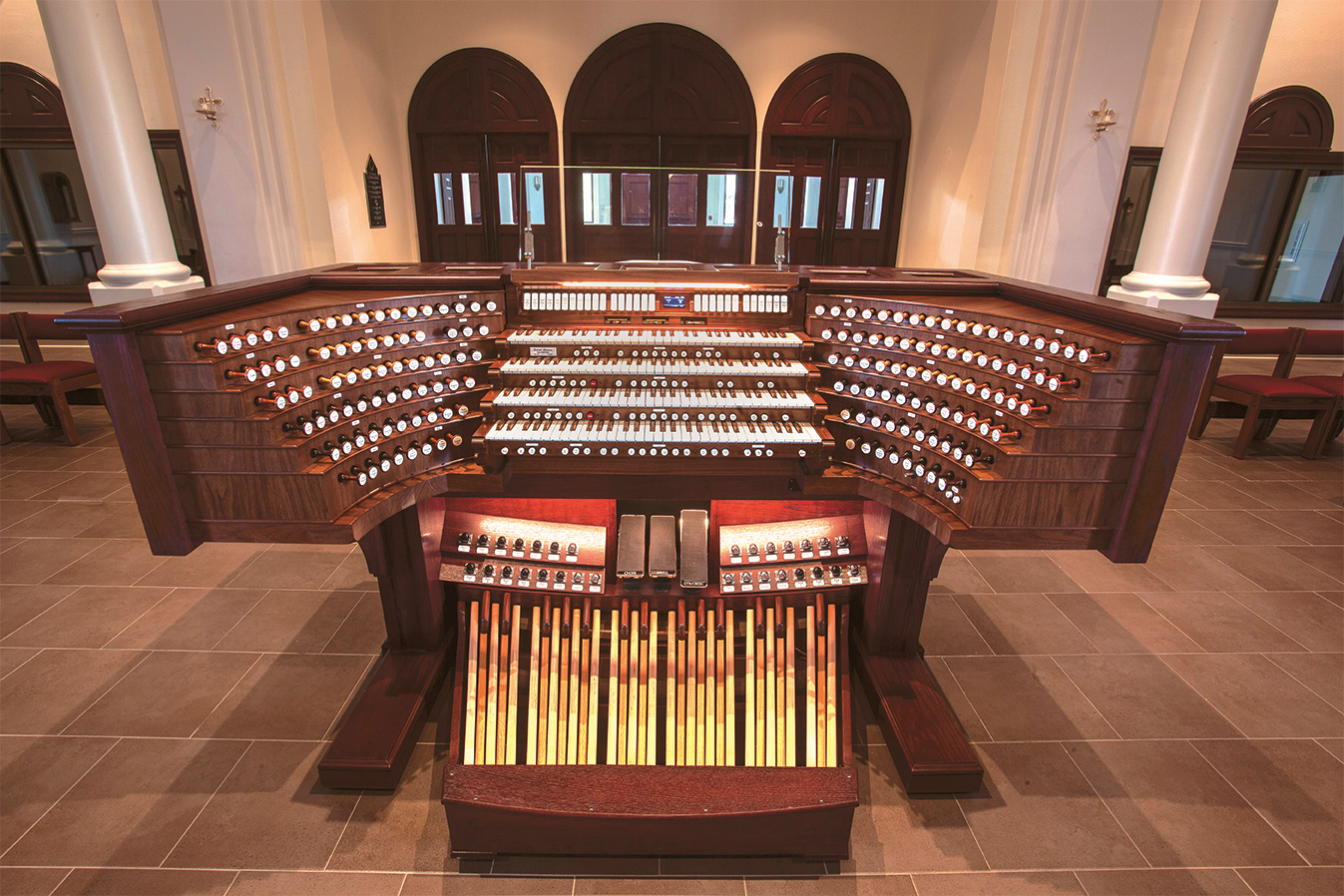












 Central United Methodist Church
Central United Methodist Church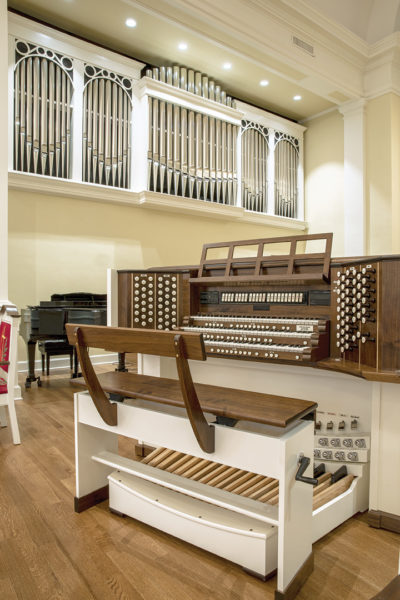 In addition to selecting an organbuilder, Frode and Scott were charged by the church to renovate and improve the acoustics of the sanctuary and to design and construct a comprehensive new two-story music suite, which wraps itself around the chancel end of the church building. The mantle for these tremendous responsibilities was placed on them in addition to their regular tasks of creating music for inspirational worship before, during, and after construction.
In addition to selecting an organbuilder, Frode and Scott were charged by the church to renovate and improve the acoustics of the sanctuary and to design and construct a comprehensive new two-story music suite, which wraps itself around the chancel end of the church building. The mantle for these tremendous responsibilities was placed on them in addition to their regular tasks of creating music for inspirational worship before, during, and after construction.

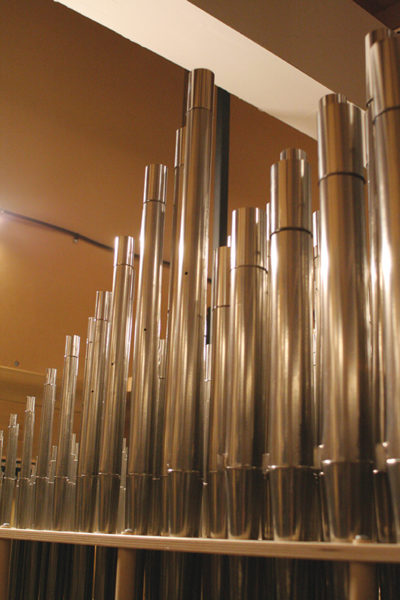
 Holy Name of Jesus Cathedral
Holy Name of Jesus Cathedral
 With these architectural/acoustical elements in place, the Fisk design team could begin the crucial layout of the divisions within the instrument. The inevitable acoustical-focusing properties of the barrel-vault ceiling all but required that the Great division’s powerful choruses should be at the top of the organ to dramatically project their speech unimpeded down the lengthy nave. The enclosed Choir division, with its primary role of choral accompaniment, was situated at the lowest level of the case, where its voices could take advantage of the reflecting walls and soffits that also surround the choristers. This division is voiced gently enough not to overwhelm, yet focused enough to be pleasantly present when heard from the nave floor. The Swell division, also under expression, is at mid-height between the other two manual divisions, speaking into the widest part of the room with no close-in support from walls or vaulting. This placement resulted in a more diffuse and ethereal sound, an appropriate contrast to the more unequivocal impact of the other manual divisions. The Pedal division, which includes three stops at 32′ pitch, somewhat less sensitive to placement at these low pitches, is arranged on several levels of the organ. It stands in close proximity to the massive back wall so that it will efficiently rumble into the room. The eight lowest pipes of the immense wooden Great Bass 32′ form the side walls of the organ case.
With these architectural/acoustical elements in place, the Fisk design team could begin the crucial layout of the divisions within the instrument. The inevitable acoustical-focusing properties of the barrel-vault ceiling all but required that the Great division’s powerful choruses should be at the top of the organ to dramatically project their speech unimpeded down the lengthy nave. The enclosed Choir division, with its primary role of choral accompaniment, was situated at the lowest level of the case, where its voices could take advantage of the reflecting walls and soffits that also surround the choristers. This division is voiced gently enough not to overwhelm, yet focused enough to be pleasantly present when heard from the nave floor. The Swell division, also under expression, is at mid-height between the other two manual divisions, speaking into the widest part of the room with no close-in support from walls or vaulting. This placement resulted in a more diffuse and ethereal sound, an appropriate contrast to the more unequivocal impact of the other manual divisions. The Pedal division, which includes three stops at 32′ pitch, somewhat less sensitive to placement at these low pitches, is arranged on several levels of the organ. It stands in close proximity to the massive back wall so that it will efficiently rumble into the room. The eight lowest pipes of the immense wooden Great Bass 32′ form the side walls of the organ case.